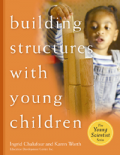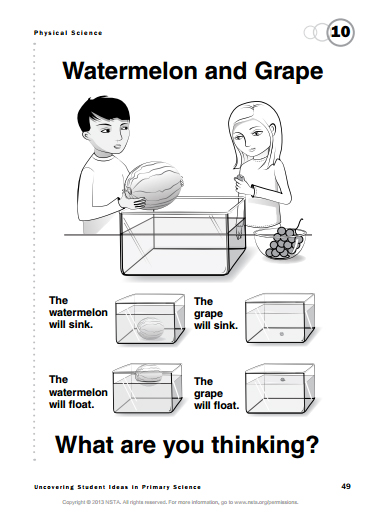Must read—take S&C home over winter break
By Peggy Ashbrook
Posted on 2014-12-14
 The December issue of Science and Children will be an issue I refer to often. Consider making it the one resource you take home with you if you have a winter break from teaching so you can have time to read and reflect on how the authors’ experiences and lesson plans might work in your classroom.
The December issue of Science and Children will be an issue I refer to often. Consider making it the one resource you take home with you if you have a winter break from teaching so you can have time to read and reflect on how the authors’ experiences and lesson plans might work in your classroom.
Here are just some of the reasons why this issue is such a useful resource for early childhood educators:
 Programs in cold weather areas may find themselves indoors more in the winter, with children spending a lot more time building with blocks. Learn about the resource book, Building Structures with Young Children, by Ingrid Chalufour and Karen Worth, in the Early Childhood Resources Review column, reviewed by Beth Van Meeteren.
Programs in cold weather areas may find themselves indoors more in the winter, with children spending a lot more time building with blocks. Learn about the resource book, Building Structures with Young Children, by Ingrid Chalufour and Karen Worth, in the Early Childhood Resources Review column, reviewed by Beth Van Meeteren.
 What are important reasons for doing sink and float activities with young children? Page Keeley’s formative assessment probe column, Watermelon and Grape: An Intuitive Rule of Quantity and Proportion, shows us how to help children move past the “More A-More B” intuitive rule, while having fun and exploring the properties of water. This column generously shares probes from Keeley’s books.
What are important reasons for doing sink and float activities with young children? Page Keeley’s formative assessment probe column, Watermelon and Grape: An Intuitive Rule of Quantity and Proportion, shows us how to help children move past the “More A-More B” intuitive rule, while having fun and exploring the properties of water. This column generously shares probes from Keeley’s books.
 Doing fieldwork in “your own backyard” with elementary students can bridge areas of knowledge, helping students see how core ideas extend beyond the boundaries of a single science discipline. The article, Observing Life in a Square, by Meredith Park Rogers and Melonie Steele, emphasizes how time—8 weeks, 3 days a week for 45 minutes—is an essential part of learning to work like scientists. Designed for grade 2, but the authors offer ways to use it in grades K, 3 and 5.
Doing fieldwork in “your own backyard” with elementary students can bridge areas of knowledge, helping students see how core ideas extend beyond the boundaries of a single science discipline. The article, Observing Life in a Square, by Meredith Park Rogers and Melonie Steele, emphasizes how time—8 weeks, 3 days a week for 45 minutes—is an essential part of learning to work like scientists. Designed for grade 2, but the authors offer ways to use it in grades K, 3 and 5.
 Pre-service and in-service teachers will find “Shrieks and Shrills: Exploring sound with preschoolers” by Mandy McCormick Smith and Kathy Cabe Trundle a complete guide to implementing an exploration, or study, of sound. The authors note that after beginning with children’s interests, the “skill of asking children productive questions is an important next step in moving from incidental to intentional learning, with focused and planned exploration.” Later they encourage exploration of student-devised questions. The authors state that explorations that provide a well-rounded authentic learning experience do not happen in a once a week science time but are part of a lengthy unit, and they provide the information so we can explore with our students.
Pre-service and in-service teachers will find “Shrieks and Shrills: Exploring sound with preschoolers” by Mandy McCormick Smith and Kathy Cabe Trundle a complete guide to implementing an exploration, or study, of sound. The authors note that after beginning with children’s interests, the “skill of asking children productive questions is an important next step in moving from incidental to intentional learning, with focused and planned exploration.” Later they encourage exploration of student-devised questions. The authors state that explorations that provide a well-rounded authentic learning experience do not happen in a once a week science time but are part of a lengthy unit, and they provide the information so we can explore with our students.
 Will your class be investigating pollinators such as bees in the spring? Use “Bee-Wild About Pollinators!” by Bonnie Johnson, Jenny Kil, Elaine Evans and Michele Hollingsworth Koomen as a tool for designing a unit on bees. Start with outdoor observations of bees and add observations of actual honeycomb to connect the information with the natural surroundings of your school. If children are afraid of bees, the engaging activities in the unit may help them become open to observing rather than closing down. The authors describe how to help children become practiced at collecting data in natural settings by practicing counting by tallying using first paper models and then a video to count bees.
Will your class be investigating pollinators such as bees in the spring? Use “Bee-Wild About Pollinators!” by Bonnie Johnson, Jenny Kil, Elaine Evans and Michele Hollingsworth Koomen as a tool for designing a unit on bees. Start with outdoor observations of bees and add observations of actual honeycomb to connect the information with the natural surroundings of your school. If children are afraid of bees, the engaging activities in the unit may help them become open to observing rather than closing down. The authors describe how to help children become practiced at collecting data in natural settings by practicing counting by tallying using first paper models and then a video to count bees.
 Three big ideas that will help teachers get a grip on the Next Generation Science Standards (NGSS)—and help us understand what science is and how to teach it—are clearly presented in “What’s the Big Idea?,” a Methods and Strategies column by Ana K. Houseal and Peter C. Ellsworth. The authors identified these 3 ideas from research upon which the standards are based, beginning with “#1 There is more to science than I thought: A new, broader definition.” With discussion and recommendations that are like FAQs, this column will help us develop classrooms that are scientific communities where science is a social process establishing lines of evidence and using the evidence to develop and refine explanations using theories, models, hypotheses, measurements, and observations. See how teachers captured this process on the documentation board in the photo. I recommend this column as a great starting point for new teachers and those wanting to understand science more in depth, and it will be very useful in teaching preservice teachers.
Three big ideas that will help teachers get a grip on the Next Generation Science Standards (NGSS)—and help us understand what science is and how to teach it—are clearly presented in “What’s the Big Idea?,” a Methods and Strategies column by Ana K. Houseal and Peter C. Ellsworth. The authors identified these 3 ideas from research upon which the standards are based, beginning with “#1 There is more to science than I thought: A new, broader definition.” With discussion and recommendations that are like FAQs, this column will help us develop classrooms that are scientific communities where science is a social process establishing lines of evidence and using the evidence to develop and refine explanations using theories, models, hypotheses, measurements, and observations. See how teachers captured this process on the documentation board in the photo. I recommend this column as a great starting point for new teachers and those wanting to understand science more in depth, and it will be very useful in teaching preservice teachers.
Additional articles and columns that may not be focused on early childhood but make this a not-to-miss issue include, the editor’s note on Scale, Proportion and Quantity; Science 101: Why do we need standard units?; Engineering Encounters: Elephant trunks and dolphin tails; Teaching Through Tradebooks: Bigger than a breadbox; Cinderella Separates a Mixture; Gliding into Understanding; and my Early Years column, The Building Blocks of Measurement--free to all this month.
Your favorites may be different from mine—open the December issue of Science and Children as you ride the stationary bicycle, curl up next to a fireplace, or endure a long travel time over winter break and tag the pages you will come back to in January.
Disclaimer: The views expressed in this blog post are those of the author(s) and do not necessarily reflect the official position of the National Science Teaching Association (NSTA).

